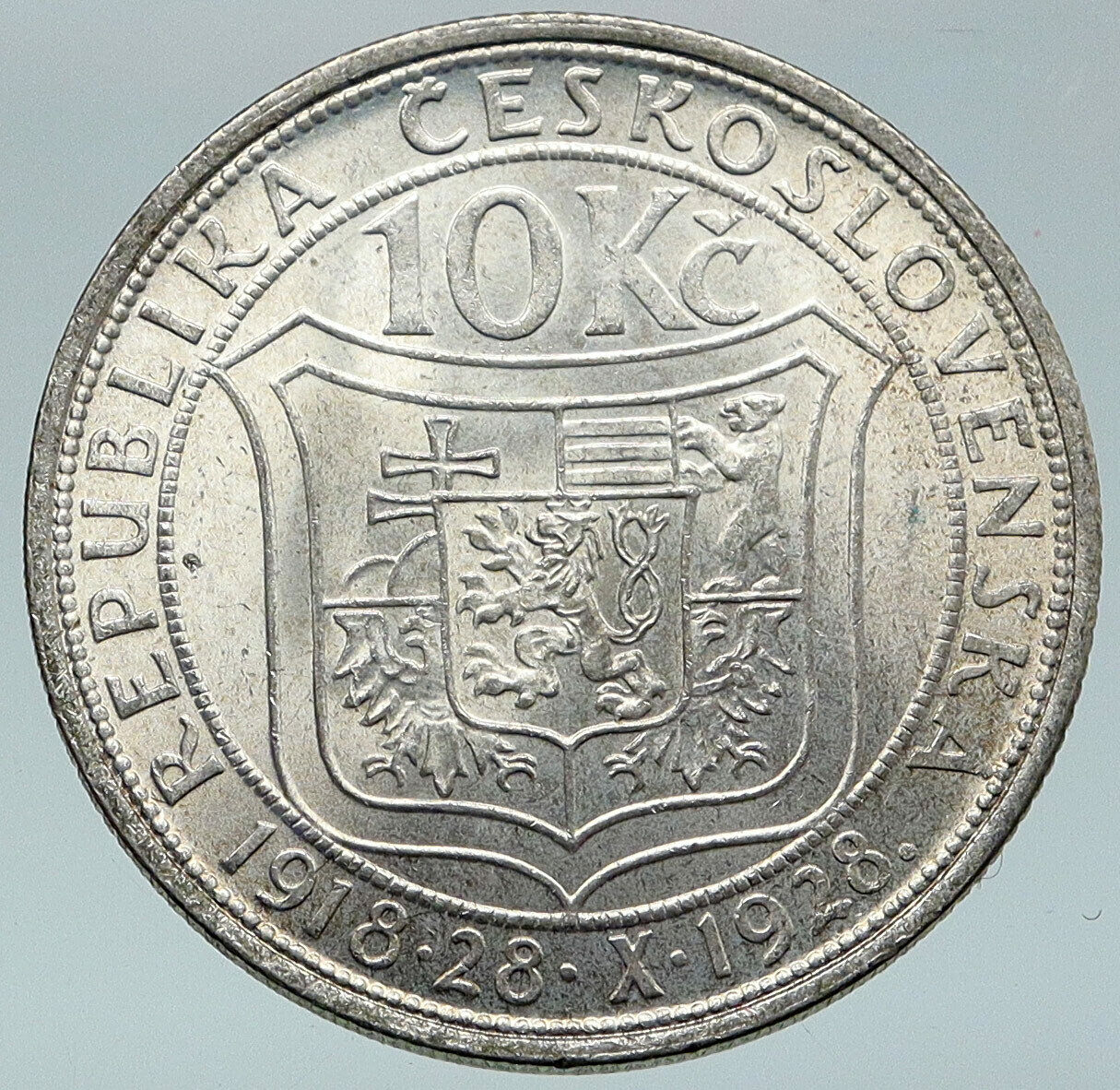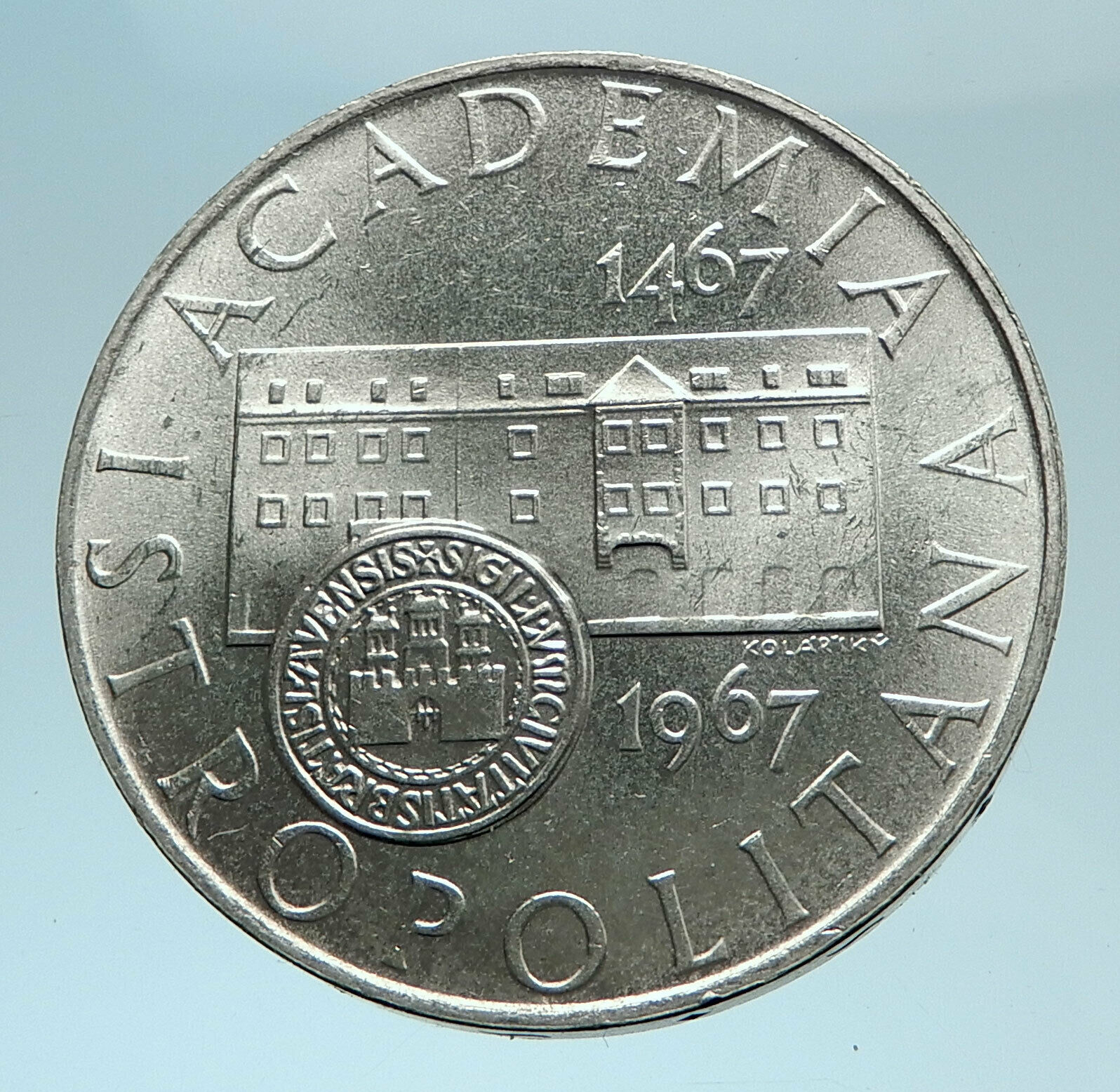|
Czechoslovakia – 30th Anniversary of 9th Communist Party Congress
1979 Silver 50 Korun 30mm (13.10 grams) 0.700 Silver (0.2926 oz. ASW)
Reference: 98 | Engraver: Vladimír Pavlica
ČESKOSLOVENSKÁ SOCIALISTICKÁ REPUBLIKA 500 KČS, Czechoslovak coat-of-arms among linden leaves.
IX. SJEZD KOMUNISTICKÉ STRANY ČESKOSLOVENSKA 1949 – 1979, Communist symbols.
You are bidding on the exact item pictured, provided with a Certificate of Authenticity and Lifetime Guarantee of Authenticity.
.svg/75px-Greater_coat_of_arms_of_Czechoslovakia_(1918-1938_and_1945-1961).svg.png) Czechoslovakia: In 1945, the Third Republic came into being, in April. Its government, installed at Košice on 4 April, then moved to Prague in May, was a National Front coalition in which three socialist parties-the Communist Party of Czechoslovakia (KSČ), the Czechoslovak Social democratic Party, and the Czechoslovak National Socialist Party-predominated. Certain non-socialist parties were included in the coalition, among them the Catholic People’s Party (in Moravia) and the Democratic Party of Slovakia. Czechoslovakia: In 1945, the Third Republic came into being, in April. Its government, installed at Košice on 4 April, then moved to Prague in May, was a National Front coalition in which three socialist parties-the Communist Party of Czechoslovakia (KSČ), the Czechoslovak Social democratic Party, and the Czechoslovak National Socialist Party-predominated. Certain non-socialist parties were included in the coalition, among them the Catholic People’s Party (in Moravia) and the Democratic Party of Slovakia.
 Following Nazi Germany’s surrender, some 2.9 million ethnic Germans were expelled from Czechoslovakia with Allied approval, their property and rights declared void by the Beneš decrees. Following Nazi Germany’s surrender, some 2.9 million ethnic Germans were expelled from Czechoslovakia with Allied approval, their property and rights declared void by the Beneš decrees.
Czechoslovakia soon came to fall within the Soviet sphere of influence..
The popular enthusiasm evoked by the Soviet armies of liberation (which was decided by compromise of Allies and Joseph Stalin at the Yalta conference in 1944) benefited the KSČ. Czechoslovaks, bitterly disappointed by the West at the Munich Agreement (1938), responded favorably to both the KSČ and the Soviet alliance. Reunited into one state after the war, the Czechs and Slovaks set national elections for the spring of 1946.
The democratic elements, led by President Edvard Beneš, hoped the Soviet Union would allow Czechoslovakia the freedom to choose its own form of government and aspired to a Czechoslovakia that would act as a bridge between East and West. Communists secured strong representation in the popularly elected National Committees, the new organs of local administration. In the May 1946 election, the KSČ won most of the popular vote in the Czech part of the bi-ethnic country (40.17%), and the more or less anti-Communist Democratic Party won in Slovakia (62%).
In sum, however, the KSČ only won a plurality of 38 percent of the vote at countrywide level. Edvard Beneš continued as president of the republic, whereas the Communist leader Klement Gottwald became prime minister. Most importantly, although the communists held only a minority of portfolios, they were able to gain control over most of the key ministries (Ministry of the Interior, etc.)
Although the communist-led government initially intended to participate in the Marshall Plan, it was forced by the Kremlin to back out. In 1947, Stalin summoned Gottwald to Moscow; upon his return to Prague, the KSČ demonstrated a significant radicalization of its tactics. On 20 February 1948, the twelve non-communist ministers resigned, in part to induce Beneš to call for early elections; however Beneš refused to accept the cabinet resignations and did not call elections. In the meantime, the KSČ marshalled its forces for the Czechoslovak coup d’état of 1948. The communist-controlled Ministry of the Interior deployed police regiments to sensitive areas and equipped a workers’ militia. On 25 February Beneš, perhaps fearing Soviet intervention, capitulated. He accepted the resignations of the dissident ministers and received a new cabinet list from Gottwald, thus completing the communist takeover under the cover of superficial legality.
On 10 March 1948, the moderate foreign minister of the government, Jan Masaryk, was found dead in suspicious circumstances that have still not been definitively proved to constitute either suicide or political assassination.
In February 1948, the Communists took power in the 1948 Czechoslovak coup d’état, and Edvard Beneš inaugurated a new cabinet led by Klement Gottwald. Czechoslovakia was declared a “people’s democracy” (until 1960) – a preliminary step toward socialism and, ultimately, communism. Bureaucratic centralism under the direction of KSČ leadership was introduced. Dissident elements were purged from all levels of society, including the Roman Catholic Church. The ideological principles of Marxism-Leninism and socialist realism pervaded cultural and intellectual life.
The economy was committed to comprehensive central planning and the abolition of private ownership of capital. Czechoslovakia became a satellite state of the Soviet Union; it was a founding member of the Council for Mutual Economic Assistance (Comecon) in 1949 and of the Warsaw Pact in 1955. The attainment of Soviet-style command socialism became the government’s avowed policy.
Slovak autonomy was constrained; the Communist Party of Slovakia (KSS) was reunited with the KSČ (Communist Party of Czechoslovakia), but retained its own identity. Following the Soviet example, Czechoslovakia began emphasizing the rapid development of heavy industry. Although Czechoslovakia’s industrial growth of 170 percent between 1948 and 1957 was impressive, it was far exceeded by that of Japan (300 percent) and the Federal Republic of Germany (almost 300 percent) and more than equaled by Austria and Greece.
Beneš refused to sign the Communist Constitution of 1948 (the Ninth-of-May Constitution) and resigned from the presidency; he was succeeded by Klement Gottwald. Gottwald died in March 1953. He was succeeded by Antonín Zápotocký as president and by Antonín Novotný as head of the KSČ.
In June 1953, thousands of workers in Plzeň went on strike to demonstrate against a currency reform that was considered a move to solidify Soviet socialism in Czechoslovakia. The demonstrations ended without significant bloodshed, disappointing American Director of Central Intelligence Allen Dulles, who wished for a pretext to help the Czechoslovak people resist the Soviets. For more than a decade thereafter, the Czechoslovak communist political structure was characterized by the orthodoxy of the leadership of party chief Antonín Novotný, who became president in 1957 when Zápotocký died.
In the 1950s, the Stalinists accused their opponents of “conspiracy against the people’s democratic order” and “high treason” in order to oust them from positions of power. In all, the Communist Party tried 14 of its former leaders in November 1952 and sentenced 11 to death. Large-scale arrests of Communists and socialists with an “international” background, i.e., those with a wartime connection with the West, veterans of the Spanish Civil War, Jews, and Slovak “bourgeois nationalists,” were followed by show trials. The outcome of these trials, serving the communist propaganda, was often known in advance and the penalties were extremely heavy, such as in the case of Milada Horáková, who was sentenced to death together with Jan Buchal, Záviš Kalandra and Oldřich Pecl.
The 1960 Constitution declared the victory of socialism and proclaimed the Czechoslovak Socialist Republic (CSSR).
De-Stalinization had a late start in Czechoslovakia. In the early 1960s, the Czechoslovak economy became severely stagnant. The industrial growth rate was the lowest in Eastern Europe. As a result, in 1965, the party approved the New Economic Model, introducing free market elements into the economy. The KSČ “Theses” of December 1965 presented the party response to the call for political reform. Democratic centralism was redefined, placing a stronger emphasis on democracy. The leading role of the KSČ was reaffirmed, but limited. Slovaks pressed for federalization. On 5 January 1968, the KSČ Central Committee elected Alexander Dubček, a Slovak reformer, to replace Novotný as first secretary of the KSČ. On 22 March 1968, Novotný resigned from the presidency and was succeeded by General Ludvík Svoboda.
|





.svg/75px-Greater_coat_of_arms_of_Czechoslovakia_(1918-1938_and_1945-1961).svg.png) Czechoslovakia: In 1945, the Third Republic came into being, in April. Its government, installed at Košice on 4 April, then moved to Prague in May, was a National Front coalition in which three socialist parties-the Communist Party of Czechoslovakia (KSČ), the Czechoslovak Social democratic Party, and the Czechoslovak National Socialist Party-predominated. Certain non-socialist parties were included in the coalition, among them the Catholic People’s Party (in Moravia) and the Democratic Party of Slovakia.
Czechoslovakia: In 1945, the Third Republic came into being, in April. Its government, installed at Košice on 4 April, then moved to Prague in May, was a National Front coalition in which three socialist parties-the Communist Party of Czechoslovakia (KSČ), the Czechoslovak Social democratic Party, and the Czechoslovak National Socialist Party-predominated. Certain non-socialist parties were included in the coalition, among them the Catholic People’s Party (in Moravia) and the Democratic Party of Slovakia.  Following Nazi Germany’s surrender, some 2.9 million ethnic Germans were expelled from Czechoslovakia with Allied approval, their property and rights declared void by the Beneš decrees.
Following Nazi Germany’s surrender, some 2.9 million ethnic Germans were expelled from Czechoslovakia with Allied approval, their property and rights declared void by the Beneš decrees. 




